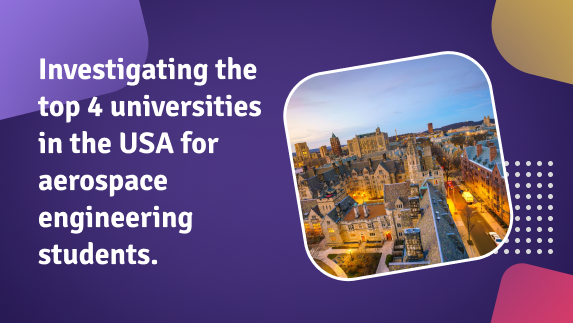Investigating the top 4 universities in the USA for aerospace engineering students.
Aerospace engineering is a highly specialized and dynamic field that combines the principles of engineering, physics, and mathematics to design, develop, and test aircraft, spacecraft, and missiles. The USA is home to some of the world’s leading institutions for aerospace engineering, known for their cutting-edge research, state-of-the-art facilities, and strong industry connections. This article explores the top four universities in the USA for aerospace engineering students, highlighting their academic strengths, facilities, research opportunities, and career prospects.
1. Massachusetts Institute of Technology (MIT)
Academic Strengths: MIT’s Department of Aeronautics and Astronautics (AeroAstro) is renowned for its rigorous and innovative curriculum. The undergraduate program focuses on the fundamentals of aerospace engineering, including aerodynamics, propulsion, structures, and control systems. MIT’s interdisciplinary approach encourages students to engage in hands-on projects and research, fostering a deep understanding of both theoretical and practical aspects of aerospace engineering.
Facilities: MIT boasts state-of-the-art facilities, including the Wright Brothers Wind Tunnel, the Gas Turbine Laboratory, and the Space Systems Laboratory. These facilities provide students with opportunities to conduct experiments and work on real-world projects. The Institute for Soldier Nanotechnologies and the Kavli Institute for Astrophysics and Space Research further enhance research opportunities for aerospace engineering students.
Research Opportunities: MIT is a leader in aerospace research, with numerous projects funded by NASA, the Department of Defense, and various aerospace companies. Students have the chance to participate in cutting-edge research in areas such as autonomous systems, space exploration, and advanced propulsion technologies. The Undergraduate Research Opportunities Program (UROP) allows students to collaborate with faculty on groundbreaking research projects.
Career Prospects: Graduates from MIT’s AeroAstro program are highly sought after by top aerospace companies, research institutions, and government agencies. The strong emphasis on research, innovation, and practical experience ensures that MIT alumni are well-prepared for careers in aerospace engineering. MIT’s extensive alumni network and strong industry connections provide valuable career opportunities and internships for students.
2. California Institute of Technology (Caltech)
Academic Strengths: Caltech’s Graduate Aerospace Laboratories (GALCIT) is a world-renowned center for aerospace education and research. The undergraduate program offers a comprehensive curriculum that covers fluid dynamics, structural mechanics, propulsion, and control systems. Caltech’s emphasis on a strong foundation in mathematics and physics prepares students for advanced study and research in aerospace engineering.
Facilities: Caltech provides students with access to cutting-edge facilities, including the Center for Autonomous Systems and Technologies (CAST), the Space Structures Laboratory, and the Graduate Aerospace Laboratories. These facilities are equipped with advanced technology and equipment, allowing students to conduct experiments and work on innovative projects. The proximity to NASA’s Jet Propulsion Laboratory (JPL) offers additional research opportunities and collaborations.
Research Opportunities: Caltech is at the forefront of aerospace research, with projects ranging from space exploration to advanced propulsion systems. Students have the opportunity to work on interdisciplinary research projects and collaborate with faculty on pioneering studies. The Summer Undergraduate Research Fellowships (SURF) program allows students to engage in independent research under the guidance of Caltech’s distinguished faculty.
Career Prospects: Caltech graduates are highly respected in the aerospace industry, known for their strong analytical skills and research capabilities. The close relationship with JPL and other aerospace institutions provides students with excellent internship and job opportunities. Caltech’s focus on fundamental science and engineering principles ensures that its alumni are well-equipped for successful careers in aerospace engineering.
3. Stanford University
Academic Strengths: Stanford University’s Department of Aeronautics and Astronautics offers a comprehensive undergraduate program that covers the core areas of aerospace engineering, including fluid mechanics, propulsion, and structural dynamics. Stanford’s interdisciplinary approach and emphasis on hands-on learning provide students with a solid foundation in both theoretical and practical aspects of aerospace engineering.
Facilities: Stanford boasts world-class facilities, including the Aerospace Computing Laboratory, the Aerospace Design Laboratory, and the Structures and Composites Laboratory. These facilities are equipped with state-of-the-art technology and tools, enabling students to conduct experiments and work on cutting-edge projects. The university’s location in Silicon Valley also provides unique opportunities for collaboration with leading tech companies and startups.
Research Opportunities: Stanford is a leader in aerospace research, with projects funded by NASA, the Department of Defense, and private industry. Students have the chance to participate in innovative research in areas such as autonomous systems, space exploration, and advanced materials. The Stanford Undergraduate Research Institute in Aerospace (SURIA) offers students the opportunity to work on interdisciplinary research projects under the mentorship of faculty.
Career Prospects: Stanford graduates are highly sought after by top aerospace companies, research institutions, and government agencies. The strong emphasis on research, innovation, and practical experience ensures that Stanford alumni are well-prepared for careers in aerospace engineering. Stanford’s extensive alumni network and strong industry connections provide valuable career opportunities and internships for students.
4. University of Michigan, Ann Arbor
Academic Strengths: The University of Michigan’s Department of Aerospace Engineering offers one of the oldest and most prestigious aerospace engineering programs in the USA. The undergraduate curriculum covers the core areas of aerospace engineering, including aerodynamics, propulsion, structures, and control systems. Michigan’s emphasis on experiential learning and interdisciplinary study prepares students for advanced research and professional practice in aerospace engineering.
Facilities: The University of Michigan provides students with access to state-of-the-art facilities, including the Wilson Student Team Project Center, the Aerospace Engineering Wind Tunnel, and the Michigan Institute for Plasma Science and Engineering. These facilities are equipped with advanced technology and tools, allowing students to conduct experiments and work on innovative projects. The university’s close proximity to major aerospace companies and research institutions offers additional opportunities for collaboration and internships.
Research Opportunities: The University of Michigan is a leader in aerospace research, with projects funded by NASA, the Department of Defense, and private industry. Students have the opportunity to participate in cutting-edge research in areas such as autonomous systems, space exploration, and advanced materials. The Undergraduate Research Opportunities Program (UROP) allows students to work on interdisciplinary research projects under the mentorship of faculty.
Career Prospects: The University of Michigan graduates are highly respected in the aerospace industry, known for their strong analytical skills and research capabilities. The university’s close relationship with major aerospace companies and research institutions provides students with excellent internship and job opportunities. Michigan’s focus on experiential learning and interdisciplinary study ensures that its alumni are well-equipped for successful careers in aerospace engineering.
Conclusion
MIT, Caltech, Stanford University, and the University of Michigan, Ann Arbor represent the pinnacle of aerospace engineering education in the USA. These institutions offer rigorous academic programs, cutting-edge facilities, and strong career prospects, making them ideal choices for students aspiring to excel in the field of aerospace engineering. Their commitment to innovation, research, and practical experience ensures that graduates are well-prepared to tackle the complex challenges of contemporary aerospace engineering. For students seeking a comprehensive and enriching education in aerospace engineering, these universities provide the perfect foundation for a successful and fulfilling.










